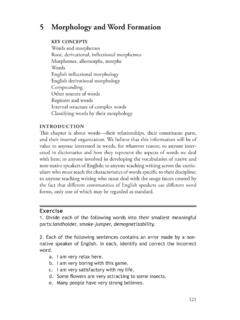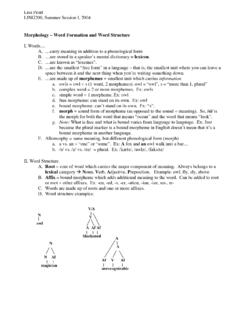Transcription of CHAPTER 7 ENGLISH MORPHOLOGY Structure meaning in …
1 CHAPTER 7: ENGLISH MORPHOLOGY : Structure meaning in Words CHAPTER 7. ENGLISH MORPHOLOGY : Structure meaning in words orphology is the study of how words are structured and how they are put together from smaller parts. To convey meaning , sounds are combined into words. But in fact, words are not the smallest unit of meaning . Many words are made of smaller units of meaning , and these units are combined in particular ways, forming words. Morpheme A morpheme, designated with braces, { }, is smallest meaning - bearing unit of language. For example, {re-} is not a word, but it does carry meaning . A morpheme ordinarily consists of a sequence of one or more phonemes. Yule (2002) states that a morpheme is the minimal linguistic unit which has a meaning or grammatical function.
2 111 | P a g e Linguistics for ENGLISH Language Teaching: Sounds, Words and Sentences Units of grammatical function include forms used to indicate past tense or plural. In the sentence The police reopened the investigation, the word reopened consists of three morphemes , a minimal unit is {open}, a minimal unit of meaning is {re-} ( meaning again'), and a minimal unit of grammatical function is {-ed} (indicating past-tense'). A single word may be composed of one or more morphemes : One morpheme : {boy}. {desire}. Two morphemes : {boy} + {-ish}. {desire} +{- able}. Three morphemes : {boy} +{- ish} + {-ness}. {desire} + {-able} + {-ity}. Four morphemes : {gentle} + {man} + {li} + {-ness}.
3 {un} + {desire} + {-able} + {-ity}. More than four : {un-} + {gentle} + {man} + {li} + {- ness}. morphemes {anti-} +{ dis-} + {establish} +{-ment} +. {ari} + {-an} + {-ism}. In short, a morpheme is defined as the minimal linguistic sign, a grammatical unit that is an arbitrary union of sound and a meaning and that cannot be further analyzed. Types of morphemes Free vs. Bound morphemes Many words are themselves morphemes , such as {boy} and {desire};. they cannot be broken down into smaller units and they carry meaning . But many other words consist of more than one morpheme. For example, desirable consists of two morphemes , {desire} and {- able}; desirability consists of three morphemes , {desire}, {-able} and {-ity}.
4 Most compound words, such as sandbox, are created by joining together two morphemes , in this case {sand} and {box}, each of which can be recognized as a word that carries a meaning by itself. All 112 | P a g e CHAPTER 7: ENGLISH MORPHOLOGY : Structure meaning in Words morphemes named thus far are free morpheme; that is they can exist as independent words. Another type of morpheme is the bound morpheme, which occurs only when attached to another morpheme. This type includes prefixes and suffixes of all kinds, such as {pre-}, {-ness}, {-ly}, {-ed}, and many others. The word reprinted, for instance, consists of three morphemes : the free morpheme {print} and the two bound morphemes {re-} and {-ed}.
5 Each of the three morphemes bears meaning and contributes to the overall meaning of reprinted: {print}. carries the meaning of making an impression, {re-} signifies repetition, and {-ed} designates the past tense. In general, the analysis of a word into its component morpheme requires that each morpheme occur elsewhere in the language; that is, it must occur with the same meaning either as a free morpheme or as bound morpheme in other combinations. For example, the morphemes {re-} and {-ed} in the word reprinted also occur in many other words and have the same meanings in those words. For example, in replayed, regained, and retyped, {re-} again signifies repetition and {-ed} again indicates the past tense.
6 Content (Lexical) vs. Function (grammatical) morphemes There is one more distinction between types of morphemes which it can be useful to make. Most morphemes have semantic content, that is, they either have some kind of independent, identifiable meaning or indicate a change in meaning when added to a word. Others serve only to provide information about grammatical function by relating certain words in a sentence to each other. The former are called content/lexical morphemes , the latter are called function/functional morphemes . In ENGLISH , all roots and derivational affixes are content morphemes , while inflectional affixes and such function words as preposition, {at}, {of}, articles, {a} or {an}, pronouns, {her}, and conjunctions, {but}, {or}, etc.
7 Are functional/grammatical morphemes . derivational vs . inflectional morphemes This distinction applies only to the class of bound morphemes . The more familiar terms for bound grammatical morphemes is affix. Affixes in turn can be subdivided into prefix and suffixes depending upon whether they are attached to the beginning of a lexical 113 | P a g e Linguistics for ENGLISH Language Teaching: Sounds, Words and Sentences morpheme, as depress (where {de-} is a prefix), or to the end of a lexical morpheme, as in helpful (where {-ful} is a A derivational morpheme is one that is added to a root (that is a word) to form a new word that differs, usually, in its part-of-speech classification.)
8 For example, when the suffix ness is added to adjective happy, the noun happiness is formed. Similarly, the adjective quick becomes the adverb quickly when ly is added. We may also classify such bound morphemes as un- and pre- as derivational morphemes , although these differ from ness and ly in two basic ways: (1) un- and pre- do not change the part-of-speech classification; for example, unambitious and predetermined remains adjectives, (2) the addition of un- and pre- changes the meaning of the word in a significant way, whereas the addition of ness and ly has little effect on the basic meaning of the word. In ENGLISH , prefixes are usually derivational morphemes that change the meaning but not the part-of-speech classification, whereas suffixes are usually derivational morphemes that change the part-of-speech classification but not the meaning .
9 Exceptions include joy/enjoy and dear/endear. An inflectional morpheme indicates certain grammatical properties associated with nouns and verbs, such as gender, number, case, and tense. Unlike highly inflected languages like Latin, ENGLISH has very few inflectional morphemes . In ENGLISH , the inflectional morphemes are all suffixes. The suffix s, which indicates either possession or plurality in nouns, is an inflectional morpheme; the past tense suffix . ed, which added to verbs, is another. inflectional morphemes are used to show if a word is plural or singular, if it is past tense or not, and if it is a comparative or possessive form. ENGLISH has eight inflectional morphemes , illustrated in the following sentences.
10 - Jim's two sisters are really different. - One likes to have fun and is always laughing. - The other liked to read as a child and has always taken thing seriously. - One is the loudest person in the house and the other is quieter than a mouse. From these examples, we can see that two of the inflections, -s (possessive) and s (plural), are attached to nouns. There are four inflections attached to verbs, -s (3rd person singular), -ing (present 114 | P a g e CHAPTER 7: ENGLISH MORPHOLOGY : Structure meaning in Words participle), -ed (past tense) and en (past participle). There are two inflections attached to adjective: -est (superlative) and er (comparative). In ENGLISH , all the inflectional morphemes are suffixes, as in the following table.



